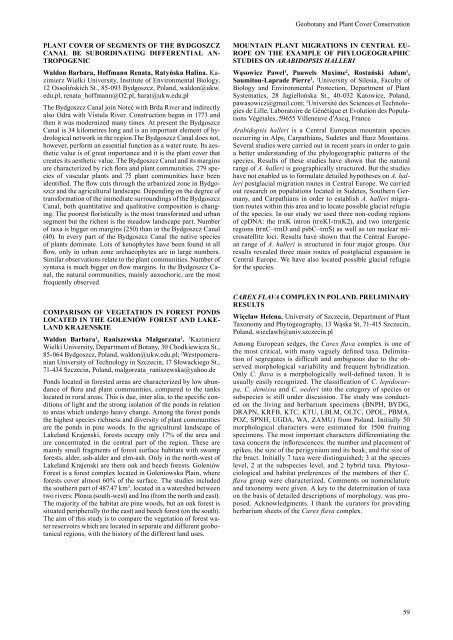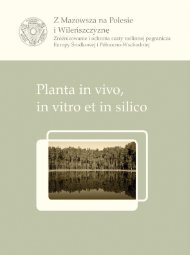acta societatis botanicorum poloniae - LV Zjazd Polskiego ...
acta societatis botanicorum poloniae - LV Zjazd Polskiego ...
acta societatis botanicorum poloniae - LV Zjazd Polskiego ...
Create successful ePaper yourself
Turn your PDF publications into a flip-book with our unique Google optimized e-Paper software.
PLANT COVEr OF SEGMENTS OF THE BYdGOSZCZ<br />
CANAL BE SUBOrdINATING dIFFErENTIAL AN-<br />
TrOPOGENIC<br />
Waldon Barbara, Hoffmann renata, Ratyńska Halina. Kazimierz<br />
Wielki University, Institute of Environmental Biology,<br />
12 Ossolińskich St., 85-093 Bydgoszcz, Poland, waldon@ukw.<br />
edu.pl, renata_hoffmann@O2.pl, harat@ukw.edu.pl<br />
The Bydgoszcz Canal join Noteć with Brda River and indirectly<br />
also Odra with Vistula River. Construction began in 1773 and<br />
then it was modernized many times. At present the Bydgoszcz<br />
Canal is 34 kilometres long and is an important element of hydrological<br />
network in the region.The Bydgoszcz Canal does not,<br />
however, perform an essential function as a water route. Its aesthetic<br />
value is of great importance and it is the plant cover that<br />
creates its aesthetic value. The Bydgoszcz Canal and its margins<br />
are characterized by rich flora and plant communities. 279 species<br />
of vascular plants and 75 plant communities have been<br />
identified. The flow cuts through the urbanized zone in Bydgoszcz<br />
and the agricultural landscape. Depending on the degree of<br />
transformation of the immediate surroundings of the Bydgoszcz<br />
Canal, both quantitative and qualitative composition is changing.<br />
The poorest floristically is the most transformed and urban<br />
segment but the richest is the meadow landscape part. Number<br />
of taxa is bigger on margins (250) than in the Bydgoszcz Canal<br />
(40). In every part of the Bydgoszcz Canal the native species<br />
of plants dominate. Lots of kenophytes have been found in all<br />
flow, only in urban zone archaeophytes are in large numbers.<br />
Similar observations relate to the plant communities. Number of<br />
syntaxa is much bigger on flow margins. In the Bydgoszcz Canal,<br />
the natural communities, mainly auxochoric, are the most<br />
frequently observed.<br />
COMPArISON OF VEGETATION IN FOrEST PONdS<br />
LoCAtED IN tHE GoLENIóW foRESt AND LAKE-<br />
LANd KrAJENSKIE<br />
Waldon Barbara 1 , Raniszewska Małgorzata 2 . 1 Kazimierz<br />
Wielki University, Department of Botany, 30 Chodkiewicza St.,<br />
85-064 Bydgoszcz, Poland, waldon@ukw.edu.pl; 2 Westpomeranian<br />
University of Technology in Szczecin, 17 Słowackiego St.,<br />
71-434 Szczecin, Poland, malgorzata_raniszewska@yahoo.de<br />
Ponds located in forested areas are characterized by low abundance<br />
of flora and plant communities, compared to the tanks<br />
located in rural areas. This is due, inter alia, to the specific conditions<br />
of light and the strong isolation of the ponds in relation<br />
to areas which undergo heavy change. Among the forest ponds<br />
the highest species richness and diversity of plant communities<br />
are the ponds in pine woods. In the agricultural landscape of<br />
Lakeland Krajenski, forests occupy only 17% of the area and<br />
are concentrated in the central part of the region. These are<br />
mainly small fragments of forest surface habitats with swamp<br />
forests, alder, ash-alder and elm-ash. Only in the north-west of<br />
Lakeland Krajenski are there oak and beech forests. Goleniów<br />
Forest is a forest complex located in Goleniowska Plain, where<br />
forests cover almost 60% of the surface. The studies included<br />
the southern part of 487.47 km 2 , located in a watershed between<br />
two rivers: Płonia (south-west) and Ina (from the north and east).<br />
The majority of the habitat are pine woods, but an oak forest is<br />
situated peripherally (to the east) and beech forest (on the south).<br />
The aim of this study is to compare the vegetation of forest water<br />
reservoirs which are located in separate and different geobotanical<br />
regions, with the history of the different land uses.<br />
Geobotany and Plant Cover Conservation<br />
MOUNTAIN PLANT MIGrATIONS IN CENTrAL EUrOPE<br />
ON THE ExAMPLE OF PHYLOGEOGrAPHIC<br />
STUdIES ON ArAbidoPsis hAlleri<br />
Wąsowicz Paweł1 , Pauwels Maxime2 , Rostański Adam1 ,<br />
Saumitou-Laprade Pierre2 . 1University of Silesia, Faculty of<br />
Biology and Environmental Protection, Department of Plant<br />
Systematics, 28 Jagiellońska St., 40-032 Katowice, Poland,<br />
pawasowicz@gmail.com; 2Université des Sciences et Technologies<br />
de Lille, Laboratoire de Génétique et Evolution des Populations<br />
Végétales, 59655 Villeneuve d’Ascq, France<br />
Arabidopsis halleri is a Central European mountain species<br />
occurring in Alps, Carpathians, Sudetes and Harz Mountains.<br />
Several studies were carried out in recent years in order to gain<br />
a better understanding of the phylogeographic patterns of the<br />
species. Results of these studies have shown that the natural<br />
range of A. halleri is geographically structured. But the studies<br />
have not enabled us to formulate detailed hypotheses on A. halleri<br />
postglacial migration routes in Central Europe. We carried<br />
out research on populations located in Sudetes, Southern Germany,<br />
and Carpathians in order to establish A. halleri migration<br />
routes within this area and to locate possible glacial refugia<br />
of the species. In our study we used three non-coding regions<br />
of cpDNA: the trnK intron (trnK1-trnK2), and two intergenic<br />
regions (trnC–trnD and psbC–trnS) as well as ten nuclear microsatellite<br />
loci. Results have shown that the Central European<br />
range of A. halleri is structured in four major groups. Our<br />
results revealed three main routes of postglacial expansion in<br />
Central Europe. We have also located possible glacial refugia<br />
for the species.<br />
cArex flAvA COMPLEx IN POLANd. PrELIMINArY<br />
rESULTS<br />
Więcław Helena. University of Szczecin, Department of Plant<br />
Taxonomy and Phytogeography, 13 Wąska St, 71-415 Szczecin,<br />
Poland, wieclawh@univ.szczecin.pl<br />
Among European sedges, the Carex flava complex is one of<br />
the most critical, with many vaguely defined taxa. Delimitation<br />
of segregates is difficult and ambiguous due to the observed<br />
morphological variability and frequent hybridization.<br />
Only C. flava is a morphologically well-defined taxon. It is<br />
usually easily recognized. The classification of C. lepidocarpa,<br />
C. demissa and C. oederi into the category of species or<br />
subspecies is still under discussion. The study was conducted<br />
on the living and herbarium specimens (BNPH, BYDG,<br />
DRAPN, KRFB, KTC, KTU, LBLM, OLTC, OPOL, PBMA,<br />
POZ, SPNH, UGDA, WA, ZAMU) from Poland. Initially 50<br />
morphological characters were estimated for 1500 fruiting<br />
specimens. The most important characters differentiating the<br />
taxa concern the inflorescences: the number and placement of<br />
spikes, the size of the perigynium and its beak, and the size of<br />
the bract. Initially 7 taxa were distinguished; 3 at the species<br />
level, 2 at the subspecies level, and 2 hybrid taxa. Phytosociological<br />
and habitat preferences of the members of ther C.<br />
flava group were characterized. Comments on nomenclature<br />
and taxonomy were given. A key to the determination of taxa<br />
on the basis of detailed descriptions of morphology, was proposed.<br />
Acknowledgments. I thank the curators for providing<br />
herbarium sheets of the Carex flava complex.<br />
59



